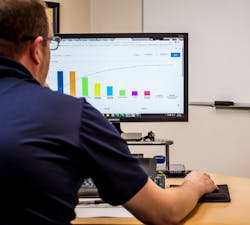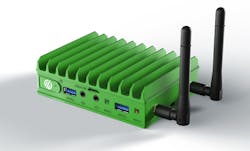Remote Machine Monitoring: A Game-Changer for Equipment Builders
One issue in manufacturing singular to OEMs is the speed with which they can respond with service to machines, especially in the case of a failure. In the past, this has usually meant an actual failure has taken place, resulting in a delayed order, scrapped parts, and downtime.
When customers require after-sales service, they expect their problem to be solved with minimum delay. Too many service calls require expensive and time-consuming on-site visits.
Service teams are dispatched, and repairs or replacement of parts are made. However, all of this takes time and creates more delay. As far as being able to predict the need for maintenance, traditional systems meant using the historical information about the machine, or simply establishing maintenance schedules, whether or not they were needed.
Having access to machine data is the best and smartest way for OEMs to improve their own manufacturing processes and machines.
Now imagine a world where machines can be monitored remotely, providing an unprecedented service level: the ability to gather real-time data and alert customers about impending issues, before any damage is done. Equipment providers require remote access to monitor and assist with user operations to troubleshoot problems, resolve service events, and monitor preventative maintenance tasks.
According to an article in Forbes, “Industry 4.0 software provides analytical tools that help OEMs understand the mechanical factors and environmental conditions that lead to machine failures. Whether it’s vibration, temperature, pressure, or other performance indicators, OEMs can use this software to analyze the machine data gathered from their IoT-enabled machines to perform predictive maintenance.”
Remote Machine Monitoring as a New Option
In fact, remote machine monitoring, enabled by industrial IoT, is the unique selling proposition that OEM and other equipment providers can offer to their clients as part of the post-sale service package. Equipment manufacturers can transform their approach to service with the ability to see, understand, and take action on their customer’s real-time machine data from anywhere at any time.
Reducing downtime, particularly unplanned downtime, is an essential part of keeping costs down and manufacturing levels up. Remote machine monitoring can collect data about the operations of any given unit and transmit that data back via the cloud, enabling OEMs to provide peak level service response time to potentially reduce this downtime for their customers.
Not all downtime is created equal; in reality the greatest expense is caused by unplanned downtime. Knowing when, where, and how it occurs is essential to knowing how to prevent it.
Historically, this servicing would require a lengthy and costly on-site visit and possible investigation into the issues being experienced. A maintenance team would not necessarily be able to detect at a glance which parts were malfunctioning, resulting in a manual process of checking each part. Instead, a remote monitoring system enables OEMs to visualize the issues via the data from anywhere. Troubleshooting even the slightest alteration in a tool path can be done quickly and easily.
Beyond service response is the ability to predict and even prevent breakdowns that severely impact a manufacturer’s production cycle by reviewing and analyzing the data produced. With predictive maintenance, OEMs can review available data, detect any exceptions or historical patterns, and service the machines in advance of a problem occurring, limiting the impact. It also ensures that a manufacturer need not maintain an extensive inventory of replacement parts, but rather work on a just in time basis.
According to New Equipment Digest, “Service departments can use data to gain insight into customers’ equipment health and condition, identify maintenance opportunities with analytics and reporting, predict and deliver early warning of potential equipment failures, highlight elevated risk areas that lead to machine downtime, or even take preventative action before it impacts a customer’s machine performance.”
Challenges with Remote Monitoring
Industry 4.0, and its vast changes to legacy processes, bring challenges to the forefront. This is particularly true when dealing with data across organizations.
- Data integrity due of the remote access.
- Cybersecurity for the network
- The ability of the software to work with different machines
- Manufacturers being unwilling to entertain different IoT solutions for different machines, to say nothing of inaccuracy in discovering the root cause of a problem should it be in a related machine that is not monitored.
SaaS platforms can address all of these issues. It will be important for SaaS platforms to have different features, including:
- The ability to encrypt data before transfer
- An easy self-installed interface with a range of machines
- Enabled manufacturers to limit their concern about having to use different monitoring solutions on factory floors
Looking Beyond Predictive Maintenance
The ability to identify service opportunities and measure ongoing process improvements is important to after-sales service but take innovation a step beyond into the realm of future design specifications.
OEM and equipment manufacturers will be able to leverage the data that they receive from their customers to improve on their existing designs—or even create better, more enhanced machines—because they will have easy access to the data that shows them how the equipment is being used. This presents an opportunity for the OEM to ensure that they stay ahead of competition.
There are two big keys to this new innovation: collecting data and the software the processes it into knowledge. But not every software processes data in the same way. For example, AI offers the following benefits over using other solutions. An AI solution could:
- Leverage unsupervised learning to make use of massive aggregate amounts of machine data to determine when machines are acting strange. These large quantities of data are necessary because if you only have a small amount, you may not be able to have the requisite samples to determine what is actually strange and what is not.
- Differentiate itself from other software by drilling through the control to capture data and collect metrics that are otherwise extremely hard to come by. For example, many other predictive analytics companies end up having to utilize solely sensor data and attempting to capture some useful information. Unfortunately, these sensors are not standardized; who knows where they’re sticking them to capture the data? An AI solution could augment data with additional sensor data to add even more useful information to the aggregate, but it’s the deep data that allows AI algorithms to derive such meaningful insights.
An example of tool and machine failure prediction in action using MachineMetrics.
Equipment manufacturers using real-time machine data can see, understand, and take action on their customers’ equipment from anywhere at any time, quickly resolving machine problems through remote diagnosis. This has shown to reduce on-site service visits by 10-20%, optimize preventative maintenance plans, validate warranty claims, receive predictive maintenance alerts to understand new service opportunities post-warranty period, and more. A rules engine can be provided for deploying monitors based on machine condition data, and machine learning algorithms can be deployed for detecting anomalous behavior.
However, a large concern for SaaS services is connecting it into current networks. IT departments don’t want to worry about an outside company messing with its network, or causing potential security risks. In addition, when considering the future of Industry 4.0, scalability is a concern. We’ve found a solution to avoiding a company’s network while not creating any incumbent inertia by building everything on a cellular edge device. By removing the necessity to connect to internal networks, where reliability is suspect at best (and often will leads to data leakage) we are able to ensure that the data is captured.
Any equipment provider, OEM or distributor can install cellular Edge device on a new machine sold to a customer or retrofit any machine currently in the field. A cellular Edge device has the ability to connect to the machine’s PLC and any additional sensors into the electrical cabinet of the machine, and allows for the data to be shared with the equipment provider. With cellular there’s no need to install on customer’s internal IT infrastructure.
Once installed, the provider can add the device to a list of machine assets accessible via the application and associate that machine with the location of the customer. Once the customer receives the machine and powers it on, that machine will appear active on the provider’s list of assets.
Security
Encrypting streaming data to a secure cloud location where the data is structured and aggregated to enable visualizations and analytics for service teams to monitor is imperative when looking for remote monitoring software. Access to the historical and real-time data is should be available through open APIs. Real-time dashboards, historical analysis, and integrations with other systems can be built with these open APIs. Another benefit to cellular is it can directly send text notifications when a monitor is triggered such as an alarm state, a limit being exceeded, or any other anomaly in the machine’s health is detected.
“For years now we have been working directly with manufacturers to improve manufacturing equipment uptime, OEE, and productivity with real-time machine monitoring and analytics,” says Bill Bither, CEO of MachineMetrics. “By allowing machines to be monitored remotely and in real time, we are enabling OEM’s to extend these benefits to their customer base while providing them with faster, better service. Our data science team is working closely with the data to deliver optimized preventative and predictive maintenance specific to their machines to improve machine uptime.”
Image of MachineMetrics Edge device. Connecting machines to a network to trap and analyze the data they provide is one thing. Doing it in a way that promotes real-time speed and accuracy—that’s the Edge.
No Better Time Than the Present
Finding new ways of operating and new revenue streams is essential for any OEM dealing with the manufacturing industry. Machines can last a long time and manufacturers don’t take kindly to the notion of planned obsolescence. With IoT, OEMs can improve the quality of their products and services, as well as open up new avenues for business that they’ve never had before. It’s a brave new world with Industry 4.0.
Having access to machine data is the best and smartest way for OEMs to improve their own manufacturing processes and machines. If they can build better machines, that are improved because the engineers have access to performance data, the OEM stands to benefit.
With remote machine monitoring, an OEM can collect data about the operations of any given unit and not only react faster to any impending issue, but even predict issues based on that data. That ability to engage in predictive maintenance from a distance is in fact an excellent unique selling proposition that OEMs can offer to their clients, as part of their service package.
OEMs will not only be able to improve their own designs but will be able to leverage the data that they receive from their customers to create different machines and designs, with less simulation and modelling required. Using the real data from existing infrastructure, the options for finding new designs or even new uses for machine designs will be unlimited, and could open up new markets and new lines for the OEM. This presents a huge opportunity for the OEM to ensure that they stay ahead of their competition.
In the end, Industrial IoT is all about data and knowledge. When it comes to staying ahead in very competitive industries, the only real leverage any company has is data. With it, they can find new ways to operate or add to their existing offerings, ensuring that they are satisfying not only their current customers, but the customer of the future as well.
Graham Immerman is director of sales and marketing at Machine Metrics.





